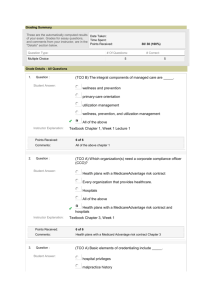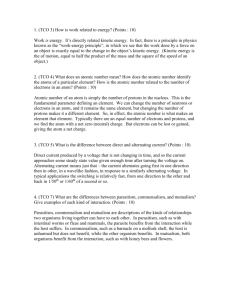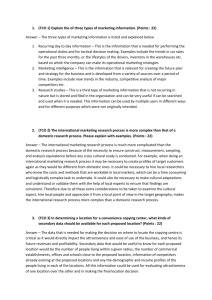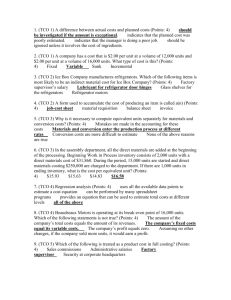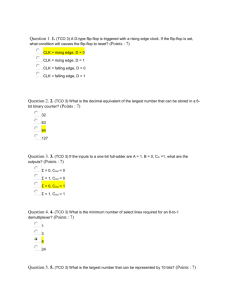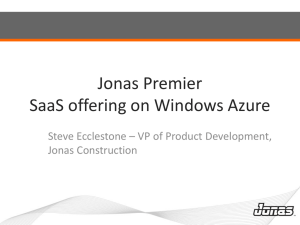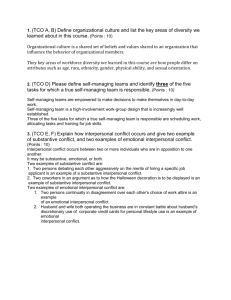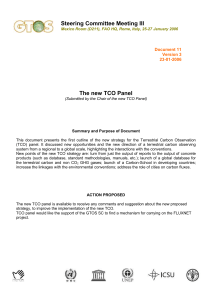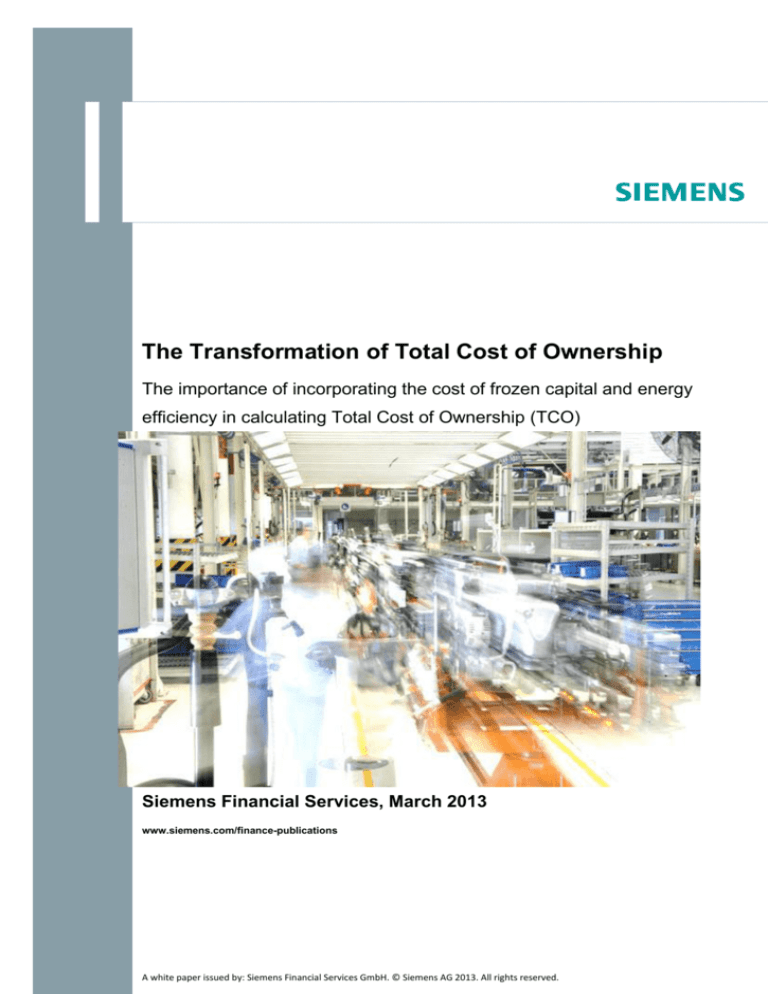
The Transformation of Total Cost of Ownership
The importance of incorporating the cost of frozen capital and energy
efficiency in calculating Total Cost of Ownership (TCO)
Siemens Financial Services, March 2013
www.siemens.com/finance-publications
A white paper issued by: Siemens Financial Services GmbH. © Siemens AG 2013. All rights reserved.
Contents
Management Summary ..................................................................................... 3
Introduction ........................................................................................................ 5
Background ....................................................................................................... 5
TCO – The Old Definition .................................................................................. 6
Putting Frozen Capital into the TCO Equation .................................................. 7
The Role of Energy Efficiency in TCO Calculations .......................................... 9
Conclusions ..................................................................................................... 11
2
Management Summary
Total Cost of Ownership (TCO), which seeks to calculate the full cost
– acquisition, operation, maintenance, training, etc. – of business
equipment, machinery and systems, is undergoing an evolution.
An increasing proportion of financial managers are now starting to
incorporate two further factors into the TCO model:– the time cost of
money and free cash flow issues (characterised by SFS as ‘frozen
capital’); and savings through energy-efficiency
Because the new TCO model has, in this way, become much more
compelling and concrete for general managers – delivering clear cash
savings - they tend to take the TCO concept much more seriously
Both these new factors raise the issue for TCO models not only of
calculating the full costs associated with equipment or machinery
(‘what it costs you’), but also the most financially efficient way of
acquiring and using that equipment (‘how you pay for it’)
Frozen capital is defined as funds that are tied up in equipment
purchase and therefore not available for alternative business
activities such as sales and marketing campaigns, new product
development or competitor acquisitions
With energy prices rising around the world, organisations are also
keen to upgrade to more energy-efficient equipment so as to reduce
their total cost of ownership
How are organisations to liberate frozen capital, and afford energyefficiency upgrades?
Bank credit remains tight in mature economies, and is expected to
remain so in the near-term in an atmosphere of slow economic
growth and concerns about stability in the Eurozone.
3
In developing economies, SMEs often find it difficult to access credit,
established businesses need to find enough financing to fuel their
rapid growth and financing arrangements need to be aligned to
operating benefits to ensure that growth is sustainable in the longterm
Against a background of restricted access to traditional credit, asset
finance techniques (particularly leasing and renting) are filling the
gap, enabling both the freeing up of frozen capital, and the ability to
invest in energy-efficient equipment
In particular, financing methods are coming to market which offset the
energy-efficient investment cost against energy savings across the
financing term, effectively providing a zero-net-cost investment
technique
This paper reviews these emerging shape of TCO, which is now
embracing these two additional payback factors, and is gaining wider
recognition with general management
4
Introduction
What is total cost of ownership, or TCO? TCO is a financial model or estimate whose
purpose is to help enterprise managers determine the direct and indirect costs of a product
or system, rather than simply the purchase cost of equipment. It is formulated into
management accounting systems that can be used in full cost accounting or – latterly –
environmental economics where it includes energy-efficiency impacts, carbon emission
costs and social costs. In manufacturing, TCO is starting to embrace (lost) opportunity costs
of not upgrading key technology (whether in terms of energy consumption or productivity).
This also extends to other technology sectors, such as healthcare, buildings management
controls, public infrastructure development, IT infrastructure, space heating and air
conditioning, vehicles and a variety of motor-driven processes, to name but a few.
This paper seeks to highlight the range of factors which now have to be considered in a total
cost of ownership model. It also covers how technology acquisitions are financed –
encapsulated in the concept of frozen capital, a TCO ‘cost’ that SFS has been studying for
some years in the healthcare and industrial sectors. The authors of this paper anticipate that
this redefinition of TCO will help both equipment acquirers and equipment vendors build
credible models which calculate total cost of ownership more accurately, and thereby enable
more intelligent acquisition decisions. This subject is of particular importance both for
embattled mature economies facing pressures of business investment decisions, as well as
developing economies seeking to make investment decisions in technology (and technology
upgrades) that produce meaningful, measurable and sustainable return on investment.
Background
Some historical background is informative. Looking at the world’s largest economy, the first
technology article in the New York Times that mentions “total cost of ownership” dates from
March 1995. Entitled “The Executive Computer; A Dinosaur in Open Systems Clothing”, it
talks about the AS/4001. Yet an advertisement from 1967 highlights total cost of ownership
as a crucial skill for a “Support Systems Life Cycle Cost Analyst” for the aerospace industry2.
The term ‘total cost of ownership’ itself has largely been focused on the IT industry, but
perhaps only because the IT industry has generated the largest body of press comment in
recent decades. TCO analysis was popularized by the Gartner Group in 19873. Yet this
was long into the term’s history. A 1976 article in the Journal of Finance, “Leasing, Buying,
1
New York Times, “The executive Computer; A Dinosaur in Open System Clothes”, 5 March 1995
ibid
3
Gartner, “Defining Gartner Total Costs of Ownership”, 8 December 2005
2
5
and the Cost of Capital Services,” discusses the “total cost of ownership” for production
machinery. More remarkably, a review in Quality Progress from 1968 notes, “Total cost of
ownership is being used profitably in the elevator industry.”4
Since these early uses of the phrase ‘total cost of ownership’, there has been a considerable
body of analysis covering TCO in various applications5, whether IT, manufacturing, productto-market, facilities management, data centre operations6 or other spheres.
TCO – The Old Definition
How much does an industrial pump cost? How much does an office air-conditioning system
cost? How much does a hospital heating and lighting system cost? What does a data
centre cost? It is still the case that most business leaders – whether corporate executives,
facilities managers or plant engineers will answer with the purchase price. In fact, however,
capital outlay is only a fraction of total operating expenses for factory plant, buildings
technology, healthcare equipment, IT and a host of other technology types. Total cost of
ownership (TCO) also embraces administration, maintenance, service, outages (time lost
when the equipment fails), user training and so on. At least, these are the factors which
have been calculated as part of the TCO models to date. As an illustration of the importance
of TCO calculations, one example from the chemical industry notes that “initial cost typically
represents less than 10 per cent of TCO.7”
While TCO cost accounting embracing these additional factors is loosely followed by most
financial directors and management accountants, there has also always been a level of
general management scepticism about too slavish adherence to TCO, mainly because many
technology providers have tried to use the concept as a means of persuading buyers to
upgrade their equipment. Part of their argument has been that, not only will maintenance
costs increase as equipment gets older, but there will be an opportunity loss from not having
access to the latest, most productive equipment. Internal buyers, quite rightly, only value
productivity gain if ultimately it can produce increased sales and greater market share.
Since this is dependent on sales success, then success is dependent on more variables
than simply acquiring the new equipment.
4
Processor, “What’s Old is New”, March 2008
See, for instance:Philipp Kuhn, “Darstellung und Analyse des Total Cost of Ownership-Ansatzes”, 2012;
Construction Management Association of America, Creighton & Jobs, “Make a Case for Sustainability: Apply Total Cost of
Ownership”, 2011;
B.Wesner, “How to Minimize the Total Cost of Ownership”, May 2010
6
Data Center Knowledge, “Key factors impacting total cost of ownership”, July 2012
7
T Dabbs, “Optimizing Total Cost of Ownership (TCO)”, 2010
5
6
However, TCO appears to be undergoing something of a renaissance, mainly as a result of
two new metrics which pioneering financial managers are now starting to factor into their
cost models. Those two factors are (1) the cost of frozen capital and (2) savings from
energy efficiency. The first of these is critical, especially in the current global economy, to
being able to compete and grow. The second saves money from the bottom line from day
one, making the investment lower- or no net cost. The following two sections describe
these factors and explain how they are making TCO a key subject not just for financial
management, but for managers and directors across the board.
Putting Frozen Capital into the TCO Equation
For some years, Siemens Financial Services has been studying financing techniques in a
number of different areas, within both the public and private sector, particularly industry and
healthcare. One of the most compelling findings of these studies has been that both of
these sectors are not making the most efficient use of available financing tools. Literally
billions (of dollars, euros, pounds, remnimbi, etc.) of capital equipment spending annually is
being tied up in outright equipment purchasing, with the result that these funds are ‘frozen’,
unable to be used for other purposes. Inability to access this frozen capital – especially
when access to capital has become restricted – is increasingly recognised as a TCO ‘cost’.
The Siemens studies have examined the frozen capital situation both in mature economies
(US, UK, France, Germany and Spain) as well as in higher growth economies (Russia,
Poland, Turkey, India and China). In mature economies, frozen capital is a problem
because organisations are finding it more difficult to access affordable borrowing since the
financial markets crisis and subsequent economic downturn. With regulators in the Western
world having universally tightened capital adequacy rules for banks, then this situation is
likely to become a permanent one. In terms of total cost of ownership, frozen capital must
be taken into account as an opportunity cost. For a commercial organisation, this
opportunity cost might be not having the funds to mount a tactical sales or marketing
campaign, or develop a new product, or even make a competitor or development acquisition.
In the public services, frozen capital robs liquid funds to deliver greater levels of front-line
services.
7
In higher growth economies, frozen capital prevents access to sufficient funds just at the
moment when they are needed. In other words, an organisation which has purchased
equipment outright in its first phase of development may have used up its available lines of
credit. However, the organisation requires further credit to maintain its rapid growth path and
seize all the opportunities in front of it. A further
factor is one of sustainability. Although higher
growth countries are keen to build their business
and public infrastructure quickly, they are also very
keen to ensure that this is done in a financially
sustainable way. No nation wants its meteoric
growth to come to a halt because it is financially
unsustainable. Therefore, there is considerable
interest in financing techniques which align
outgoings (monthly/regular payments) with financial
benefits (such as reduced costs, greater throughput
Billions of capital equipment spending is being
tied up in outright equipment purchasing
annually. As a result, these funds are “frozen” and
cannot be deployed for other value-driven
business activities such as marketing campaign or
competitor acquisition. In terms of total cost of
ownership, this frozen capital must be taken into
account as an opportunity cost. By aligning
outgoings (payments) with benefits
(savings/productivity), asset finance allows
organisations access to the latest technology,
without the opportunity cost of tying up large
amounts of capital.
or improved productivity).
In short, leading financial managers are paying attention not just to what something costs,
but how they pay for it. What is the best application for an organisation’s own funds, and
when should it access private sector capital to finance its capital equipment acquisitions,
leaving its own cash free for more nimble competitive or service delivery uses? Asset
finance solutions are being seen as particularly appropriate to the TCO mind-set because,
rather than simply funding the purchase cost of equipment or systems, they can also cover
other TCO requirements, such as installation, maintenance, service, training, even upgrades
and consumables. In other words, asset finance allows access to the latest business
technology, without the opportunity cost of tying up large amounts of capital – making an
important positive contribution to TCO.
8
The Role of Energy Efficiency in TCO Calculations
Equally compelling as the issue of frozen capital, is that of energy-efficiency. Out-dated
equipment, be it manufacturing plant, air conditioning, lighting, cooling or heating, is
consuming far more energy than modern alternatives. Moreover, all over the world, the
trajectory of energy prices is inexorably rising8.
Take the example of industrial motors (which drive pumps, fans, production lines and so on).
Worldwide, there are approximately 20 million industrial motors—with vast potential for
saving energy9. Drive technology accounts for two-thirds of industrial energy consumption10.
Given that energy-efficient industrial drives have a service life of ten years, in an example
where there are 2,000 hours of operation annually, the acquisition cost accounts for less
than 3% of total costs. Energy costs, by contrast, account for over 95%.
Heating, ventilation and air conditioning (HVAC) is another chief consumer of power.
According to one respected research organisation11, “Air conditioning can increase a
building's energy consumption and associated carbon emissions by up to 100%. Heating
and hot water can account for 60% of total energy costs." Technologies that enable
combined heat and power (CHP) can make a significant contribution to improving energy
efficiency by generating electricity and heat simultaneously. Ideally, the demand for heat is
first reduced, and then the CHP scheme is sized to meet the new heat load. In some
schemes, overall efficiency is further improved by ‘trigeneration’ – using additional
absorption chillers to convert waste heat into cooling.
In addition, improved buildings automation can also provide up to 80% of potential savings in
an organisation. Implemented correctly, automation can increase productivity, reduce
downtime and minimise maintenance requirements – whilst simultaneously cutting energy
consumption and reducing carbon emissions.
So organisations face a dilemma. They know they need to upgrade out-dated equipment
and infrastructure to improve efficiency and productivity12, but this can be at the time when
their traditional sources of finance are becoming reluctant to lend (in mature economies), or
8
AFP, “China hikes industrial electricity prices”, 30 May, 2011;
CCTV News Channel, 31 May 2011;
Financial Times,” China forced to ration electricity”, May 17 2011;
Prayas Energy Group, N. Rao, G.S. Sant, S.C. Rajan, “An overview of Indian Energy Trends”, 2009;
BBC, “Can foreign firms make Russia’s electricity cheaper?”, 31 March 2011;
NewsBCM, “Rise in Russia’s hydro rates not to exceed 15% in 2011”, 21 March 2011;
OECD : “Transition to a Low-Carbon Economy, Public Goals and Corporate Practices”, 2010
9
Siemens, “Top 10 energy saving options“, 2011
10
ibid
11
The Carbon Trust
12
See, for instance:- Financial Times, “Manufacturers fire broadside at coalition”, 3 August 2011; Financial Mail,” Firms cannot
put off capital expenditure any longer”, 10 July 2011
9
where their rapid growth path is making it difficult to access sufficient capital for equipment
upgrades (higher growth economies).
Once again, financing techniques can come into play to fund these energy-efficiency
investments in a way that does not freeze capital and helps minimise total cost of ownership.
Asset finance plans are emerging on the market specifically
designed to enable energy-efficiency investments. In a
nutshell, these schemes wrap everything into a single
financing package, including the energy efficiency
assessment, the equipment itself, installation etc., all via a
loan, lease, rental or hire purchase arrangement. Payments
are designed to be equal to, or lower than, the energy
savings and in many cases deliver savings and net positive
cash flow immediately. Where a project cannot completely
Rising energy prices make energy
efficiency a key consideration in TCO
calculations. Asset finance solutions
help organisations acquire energyefficient equipment by offsetting the
investment costs against energy savings
across the financing terms, effectively
providing a zero-net-costs investment
technique.
offset the equipment upgrade with energy-efficiency cost
savings, the financing arrangement nevertheless subsidises the larger part of the upgrade
cost.
A finance agreement under this kind of integrated scheme has the potential advantage of tax
efficient, fixed payments for the agreement term, which are calculated taking into account
the type of equipment, its expected working life and the customer’s individual circumstances.
In addition, the customer taking out the finance may be able to wrap other aspects such as
service into their monthly payments, as well as negotiate upgrades and add-ons in the future
as their needs change.
10
Conclusions
Within business environments, economists have for many years advocated ownership of
appreciating assets (property being the classic example) and the ‘rental’ or leasing of
depreciating ones (vehicles and technology). Therefore, TCO models are now not only
focusing on the full range of costs of acquiring and operating their key business equipment
and systems (“what you pay”), but are also now embracing financing methods (“how you
pay”) into the TCO equation.
In particular, organisations want to avoid the opportunity cost tying up, or ‘freezing’, funds in
equipment purchase that is better deployed on competitive drives, value acquisitions or
improved service delivery. In addition, with energy costs continually rising, energy-efficiency
has become a key component of TCO calcuations, recognising the need to eliminate
unnecessary energy spending where possible.
Asset financing techniques – espeically leasing arrangements – appear to be filling the gap
left by restricted access to traditional business credit. They are able to cover equipment,
maintenance, service, training, even upgrade – and are therefore particularly suited to the
TCO approach. And they are often the favoured method used to create financing packages
that align outgoings (payments) with benefits (savings/productivity), especially in a world
where access to traditional forms of bank credit look like they will be permanently squeezed
under the new, more exacting, regulatory regime.
11

